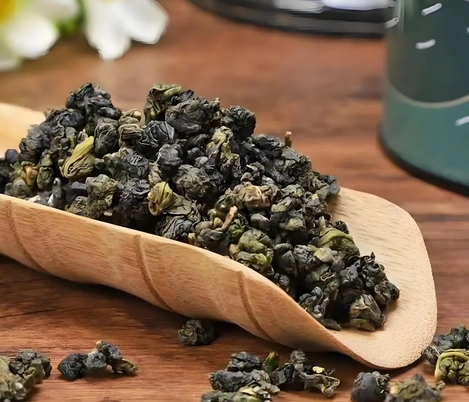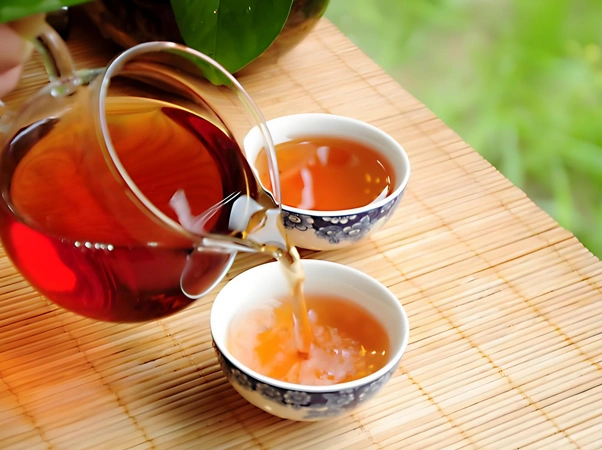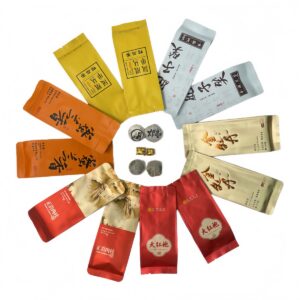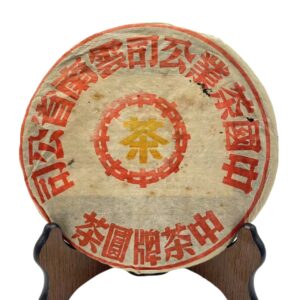Imagine the first light of dawn filtering through your window as you cradle a warm cup of oolong tea, its fragrant steam carrying whispers of garden florals and toasted chestnuts. Each sip feels like a gentle caress for your skin and soul—a moment of serenity that promises lasting wellness.
Oolong tea and aging share a powerful connection: centuries of tradition reveal that this semi-oxidized tea can support youthful vitality, boost metabolism, and soothe the mind. In this guide, you’ll discover how oolong tea benefits stem from its unique production, learn the science behind its anti-aging effects, master brewing techniques to maximize potency, and integrate oolong tea into daily rituals—from morning metabolism kick-offs to evening relaxation. Ready to turn back the clock naturally? Let’s steep ourselves in the world of oolong tea and aging.
What Is Oolong Tea?
Oolong tea bridges the gap between green and black teas through a partial oxidation process. Plucked from tea gardens in Fujian and Taiwan, leaves undergo:
- Withering under sun and breeze to lose moisture.
- Bruising by tossing in bamboo baskets, initiating oxidation.
- Oxidation controlled between 10–70%, shaping delicate toasty or rich fruity notes.
- Firing in hot ovens to halt oxidation and lock in aroma.
Iconic varieties include:
- Da Hong Pao (Wuyi Rock Tea): Deeply roasted, mineral-rich rock character.
- Tieguanyin: Floral, buttery, with orchid and honey undertones.
These signature teas exemplify how nuanced production creates a spectrum of flavors—and potent health benefits.

The Science Behind Oolong Tea and Aging
Antioxidants & Polyphenols
Oolong tea’s partial oxidation produces abundant polyphenols—notably EGCg, theaflavins, and thearubigins. These compounds:
- Neutralize free radicals, protecting skin cells from oxidative damage.
- Support collagen integrity, maintaining skin elasticity and reducing wrinkle formation.
Methylxanthines & Metabolism Boost
Oolong tea contains caffeine and theobromine, stimulating metabolism without the jittery crash of coffee:
- Thermogenesis: Increases calorie burn at rest.
- Lipolysis: Encourages the breakdown of stored fat.
This metabolism boost complements anti-aging by helping maintain a lean physique and healthy energy balance.
Top Anti-Aging Benefits of Oolong Tea
Skin Health & Collagen Support
Regular consumption of oolong tea benefits your skin by:
- Combating UV-induced damage: Polyphenols soothe inflammation and reduce sunburn risk.
- Promoting hydration: Mild diuretic effect flushes toxins while maintaining moisture balance.
Cognitive Function & Neuroprotection
Oolong tea’s theanine works alongside caffeine to enhance:
- Focus and clarity without overstimulation.
- Neuroprotective effects, reducing risk of age-related cognitive decline.
Metabolic Rate & Weight Management
Studies link oolong tea weight loss effects to:
- Increased fat oxidation during exercise and rest.
- Reduced cholesterol levels, supporting cardiovascular aging health.
By integrating oolong tea into a balanced diet, you nurture body and mind as you age.
Brewing Oolong Tea for Maximum Anti-Aging Effects
Optimal Water Temperature & Steep Times
To extract the perfect balance of flavor and health compounds:
- Water Temperature: 95–100 °C to coax out floral notes without bitterness.
- Steep Time:
- Short Steep (2–3 minutes) for delicate, floral infusions.
- Long Steep (5–7 minutes) for deeper roasted, mineral-rich profiles.
Gongfu vs Western Brewing
- Gongfu Style:
- Use 5–7 g leaves per 100 ml water in a small Yixing pot or gaiwan.
- Rinse leaves for 5 s, discard rinse.
- Infuse 10–20 s per steep, enjoying 8–12 infusions—each unveiling new aromatics.
- Western Steeping:
- Use 2 g leaves per 200 ml water in a teapot.
- Steep 3–5 minutes; adjust to taste.
Experiment to find your ideal balance of taste and healthful compounds.

Daily Rituals: Integrating Oolong Tea into Your Anti-Aging Routine
Morning Metabolism Kick-off
Begin your day with a bright tieguanyin steep:
- Tieguanyin Oolong Tea offers floral lifts that awaken focus and boost thermogenesis.
- Recommended: Tieguanyin Oolong Tea
Midday Skin Hydration Break
At lunchtime, sip on Da Hong Pao:
- Da Hong Pao (Wuyi Rock Tea) provides earthy minerality and antioxidants to combat midday oxidative stress.
- Recommended: Da Hong Pao Wuyi Rock Tea
Evening Relaxation & Recuperation
Wind down with a gentle cold brew:
- Cold Brew Oolong: Steep leaves overnight in cold water for a smooth, low-caffeine infusion—perfect for unhurried evenings.
Consistent timing helps your body anticipate and maximize oolong tea and aging benefits.
Oolong Tea Recipes & Pairing Tips
Iced Oolong & Citrus Elixir
- Ingredients: Strong cold-brewed oolong, fresh orange slices, a sprig of rosemary.
- Method: Steep 10 g leaves in 500 ml water for 8 hours, strain, add citrus and herbs, serve over ice.
Oolong Smoothie & Collagen Boost
- Ingredients: Hot-steeped oolong, mixed berries, banana, scoop of collagen peptides, ice.
- Method: Blend for a nourishing anti-aging shake, uniting tea’s antioxidants with skin-supporting collagen.
Food Pairings for Youthful Glow
- Sushi or sashimi with tieguanyin’s floral notes.
- Light salads with citrus vinaigrette complement Da Hong Pao’s mineral depth.
- Almond biscotti or honey-drizzled yogurt showcase oolong’s sweet finish.
Myth-Busting: Debunking Oolong Tea Aging Myths
“More Tea, More Anti-Aging?”
Drinking excessive oolong can lead to caffeine overconsumption. Aim for 3–4 cups daily, spaced throughout the day.
Caffeine Concerns & Timing
- Morning & Midday: Optimal for metabolism and focus.
- Late Afternoon & Evening: Choose cold brew or short steeps to minimize sleep disruption.
Balanced intake maximizes benefits without side effects.
FAQ: Oolong Tea and Aging
- Can oolong tea reduce wrinkles?
Regular antioxidants intake supports collagen health, which may minimize fine lines over time. - How much oolong tea for anti-aging?
3–4 cups daily is a sustainable dose for antioxidant and metabolic support. - Best oolong variety for longevity?
High-mountain tieguanyin for floral antioxidants, and Wuyi rock tea for potent mineral and polyphenol content.
Conclusion & Recommendations
Oolong tea and aging create a harmonious duo: from oolong tea benefits in skin health and cognitive support to anti-aging tea rituals that nurture body and spirit. By mastering brewing techniques, integrating daily rituals, and savoring creative recipes, you transform each cup into a timeless act of self-care.
Trusted 2025 Oolong Tea Sources
- Tanbiwencha:
Embrace oolong tea and aging—sip by sensuous sip, and let youthful vitality steep into every moment.



